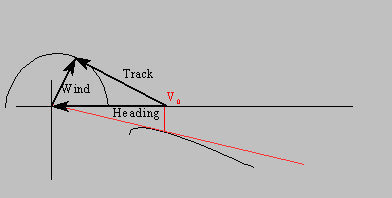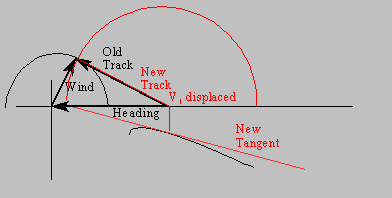

I'll focus first on a headwind. Here I've drawn the exact same tangent, but I've constructed a new, larger, wind circle, and I've added a "track circle" for the ground track:

This now says: The performance of my glider in terms of sink rate in the original 10-knot headwind will be identical to its performance in this equivalent crosswind (a stiff blast from 300, roughly). Clearly this is the only wind triangle that can be made from these two circles, but you could imagine an infinite number of triangles based on different sized wind circles, all consistent with this headwind/tangent combination.

Note that this works perfectly fine for a tailwind as well. One just has a larger track circle, and now the track vector will ALWAYS be longer than the heading vector.

I think it can be proven that you can't get a 90o intersect for the wind and track vectors to give an "effective" tailwind. (This is because in order to get a 90o intersect at least one of the arrow bases must be outside the track circle.) Thus, a crosswind with any headwind component at all can never help you!
1) Start by drawing the NO WIND tangent, giving speed "V0." Add a wind circle for the known wind, and (this is the hard part...) draw track and wind vectors which intersect the wind circle in such as way as to have the known relationship. (Here we are going for a 90 or 270 crosswind.)

2) Now draw the track circle, find its intersection with the x-axis, and draw a NEW tangent from that point, giving a new speed to fly, V1, which will be displaced to the right just a bit from Vo.

Clearly a crosswind is just like a headwind. Draw the new track vector and measure its length for the L/D calculation.
In principle, you could continue this process, drawing another track vector, track circle, intersection, tangent, etc. But the point I would make is that if you think about it, all future iterations will be between V0 and V1 . (Because now you have to rotate that wind vector just a hair CCW to reconnect with the right angle at V1, which will give a slightly smaller effective headwind, which will result in a slightly less steep slope and a slightly smaller V1, etc., etc.) In fact, the speed to fly will be very close to V1. Being a knot or two high is the safest idea, anyway. Thus, once through should be plenty.

Add some lift or sink and the story changes only in that you would then use that lift or sink line instead of the x-axis for all your circles and intersects.
If you really want to see this the way it looks in space, what you need to do is fold the diagram 90o along the base of the wind triangle so that the wind-triangle part is flat on your desk while the polar part hangs down the edge. Now that's the real 3-D picture I had in mind at the meeting!
Correct me if I'm wrong...
Happy soaring,
Bob Hanson